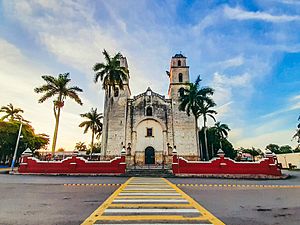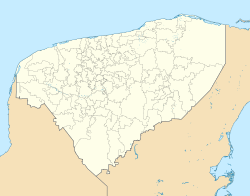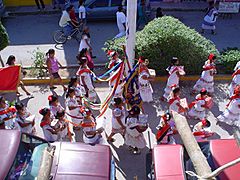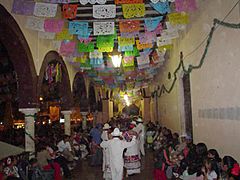Espita, Yucatán facts for kids
Quick facts for kids
Espita
|
||
|---|---|---|
|
Town
|
||
 |
||
|
||
| Motto(s):
"The Athens of Yucatan"
|
||
| Country | Mexico | |
| State | Yucatán | |
| Municipality | Espita Municipality | |
| Area | ||
| • Total | 6.47 km2 (2.50 sq mi) | |
| Elevation | 27 m (89 ft) | |
| Population
(INEGI, 2010)
|
||
| • Total | 11,551 | |
| • Density | 1,662.75/km2 (4,306.5/sq mi) | |
| Demonym(s) | espitan | |
| Time zone | UTC−6 (Central Standard Time) | |
| • Summer (DST) | UTC−5 (Central Daylight Time) | |
| ZIP Code |
97730
|
|
| Area code(s) | 986 | |
| INEGI Code | 310320001 | |
Espita is a town in Yucatán, Mexico. It's located in the eastern part of Yucatán, about 165 kilometers (102 miles) from Mérida City. It's also close to famous places like Chichen Itza and Ekʼ Balam.
Long ago, before the Spanish arrived, this area was home to the Cupules people. The Spanish founded the town we know today around 1549. They built many large buildings, including the church dedicated to St. Joseph. In the 1800s, Espita was known for its important corn farms, called haciendas. Because of its strong economy and focus on culture, Espita was even called "The Athens of Yucatan." Later, in the 1900s, the town's growth slowed down when many of the haciendas closed.
Today, Espita is the fourth largest town in eastern Yucatán. It is smaller only than Valladolid, Tizimín, and Chemax.
Contents
What's in a Name?
There are different ideas about where the name Espita came from. The most common idea is that it comes from the Yucatec Maya language words x pʼíit jaʼ. This means "little water."
The Spanish gave the town the name Espita when they arrived in Yucatán. This name stayed for about 300 years. On September 15, 1876, the town council tried to change the official name to Espita de Peniche Gutiérrez. However, people don't use this longer name today.
A Look Back in Time
Espita is an old town with many interesting traditions and historical events.
Early Days
Before the Spanish arrived, the area where Espita now stands was part of the Cupules' land. Espita was founded by the Spanish around the 1520s during the Spanish conquest of Yucatán. In 1549, the Spanish set up a system called encomienda in the town. This system gave Spanish settlers control over local people and their land.
Growing as a Town
In 1825, Espita became part of the party of Tizimin. Later, on November 30, 1840, it became the main town of its own party (a type of local government area).
The Caste War
On February 15, 1848, Espita was taken over by indigenous rebels during the Caste War. This was a big conflict in Yucatán. In 1850, the people of Espita bravely defended their town against another attack from the rebels. This event is known as "the heroic deeds of the large fifteen of Espita."
Becoming a Town
On April 29, 1852, the state government officially made Espita a town. On September 15, 1876, the town council tried to change its name to Espita de Peniche Gutiérrez, but this name is not used today.
Espita's Location and Weather
Climate
Espita has a warm climate. Here's a look at the weather throughout the year:
| Climate data for Espita | |||||||||||||
|---|---|---|---|---|---|---|---|---|---|---|---|---|---|
| Month | Jan | Feb | Mar | Apr | May | Jun | Jul | Aug | Sep | Oct | Nov | Dec | Year |
| Record high °C (°F) | 39.7 (103.5) |
35.5 (95.9) |
39.9 (103.8) |
39.3 (102.7) |
42.0 (107.6) |
39.6 (103.3) |
39.0 (102.2) |
38.9 (102.0) |
38.1 (100.6) |
38.0 (100.4) |
39.0 (102.2) |
40.0 (104.0) |
42.0 (107.6) |
| Mean daily maximum °C (°F) | 29.6 (85.3) |
30.4 (86.7) |
32.7 (90.9) |
34.8 (94.6) |
36.2 (97.2) |
34.5 (94.1) |
34.6 (94.3) |
34.4 (93.9) |
33.5 (92.3) |
32.3 (90.1) |
30.9 (87.6) |
29.8 (85.6) |
32.8 (91.0) |
| Daily mean °C (°F) | 22.8 (73.0) |
23.5 (74.3) |
25.4 (77.7) |
27.5 (81.5) |
28.8 (83.8) |
28.2 (82.8) |
27.8 (82.0) |
27.5 (81.5) |
27.0 (80.6) |
26.3 (79.3) |
24.6 (76.3) |
23.2 (73.8) |
26.1 (79.0) |
| Mean daily minimum °C (°F) | 16.1 (61.0) |
16.5 (61.7) |
18.1 (64.6) |
20.1 (68.2) |
21.4 (70.5) |
21.8 (71.2) |
20.9 (69.6) |
20.7 (69.3) |
20.4 (68.7) |
20.2 (68.4) |
18.3 (64.9) |
16.6 (61.9) |
19.3 (66.7) |
| Record low °C (°F) | 5.0 (41.0) |
7.0 (44.6) |
6.0 (42.8) |
10.6 (51.1) |
12.0 (53.6) |
11.0 (51.8) |
7.0 (44.6) |
8.0 (46.4) |
7.0 (44.6) |
11.0 (51.8) |
8.0 (46.4) |
6.5 (43.7) |
5.0 (41.0) |
| Average precipitation mm (inches) | 50.5 (1.99) |
35.2 (1.39) |
22.8 (0.90) |
39.0 (1.54) |
104.5 (4.11) |
168.6 (6.64) |
132.7 (5.22) |
142.4 (5.61) |
189.6 (7.46) |
125.2 (4.93) |
53.2 (2.09) |
47.6 (1.87) |
1,111.3 (43.75) |
| Average precipitation days | 4.1 | 3.3 | 2.2 | 2.8 | 5.6 | 10.0 | 10.6 | 11.0 | 12.4 | 10.8 | 4.7 | 4.4 | 81.9 |
| Source: Servicio Meteorológico Nacional | |||||||||||||
How Many People Live Here?
| Historical population | ||
|---|---|---|
| Year | Pop. | ±% |
| 1900 | 2,527 | — |
| 1910 | 2,441 | −3.4% |
| 1921 | 4,496 | +84.2% |
| 1930 | 4,253 | −5.4% |
| 1940 | 4,504 | +5.9% |
| 1950 | 4,948 | +9.9% |
| 1960 | 5,161 | +4.3% |
| 1970 | 5,394 | +4.5% |
| 1980 | 5,779 | +7.1% |
| 1990 | 8,279 | +43.3% |
| 2000 | 9,375 | +13.2% |
| 2010 | 11,551 | +23.2% |
| Source: Archivo Histórico de Localidades | ||
In 2005, a study by INEGI showed that 10,758 people lived in Espita. This was about 74.54% of all the people in the municipality. There were slightly more men (5,429) than women (5,329). Experts thought the population would grow to about 12,110 people by 2010.
Learning in Espita
Espita has several schools for different age groups. Here's a quick look at the number of students, teachers, and schools:
| Type | Students | Teachers | Schools |
|---|---|---|---|
| Preschool education | 569 | 21 | 4 |
| Primary education | 1 829 | 59 | 6 |
| Secondary education | 485 | 40 | 2 |
| High school | 368 | 25 | 1 |
| Total | 3 251 | 145 | 13 |
| Source: Secretaría de Educación de Yucatán. | |||
Fun and Culture
Popular Festivities
Espita celebrates many fun events throughout the year.
Baby Jesus Festival
The biggest celebrations are for baby Jesus, who is one of the town's patron saints along with Saint Joseph. These festivities happen from December 19 to 29. December 25 is the most important day.
During this time, there are:
- Religious ceremonies
- Bullfights
- Gremios (special daytime dances)
- Evening dances
- Traditional vaquerías (cowboy dances)
On the last day, people often walk around town and sing "Happy Birthday" to the saint with mariachi music. The town fair usually continues until December 31. Many visitors come from nearby towns, and families who used to live in Espita return for the celebrations. Since 2009, a group called "Asociación de Palqueros en Fortalecimiento de Nuestras Tradiciones" helps organize these events.
Saint Joseph's Day
In March, Espita also celebrates Saint Joseph. He has been an important figure in the community since before 1650, and the town's church is named after him. However, this celebration is smaller than the December festival. It mainly includes masses and doesn't have the big community dances or bullfights.
- Espita at December
See also
 In Spanish: Espita para niños
In Spanish: Espita para niños







